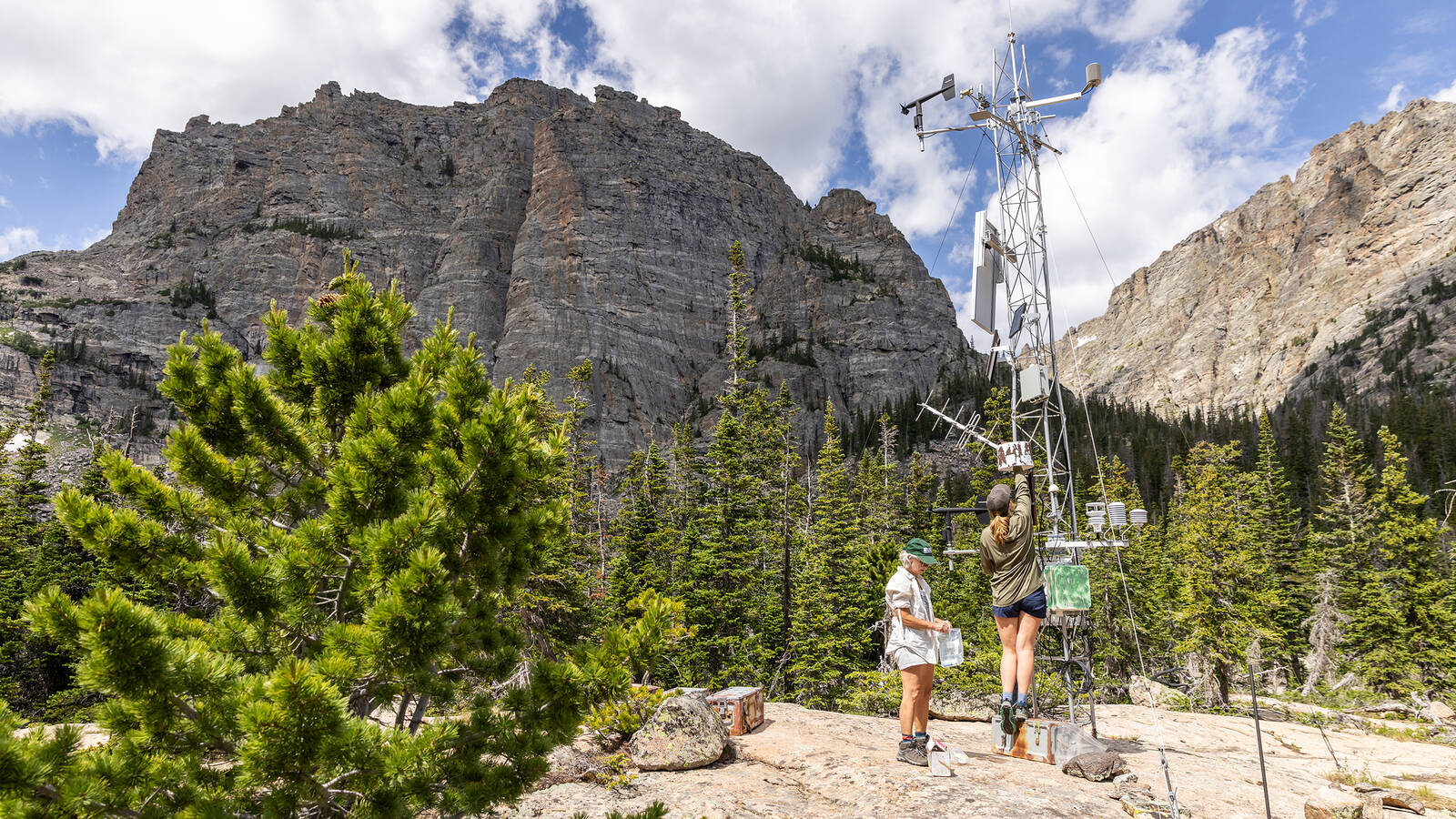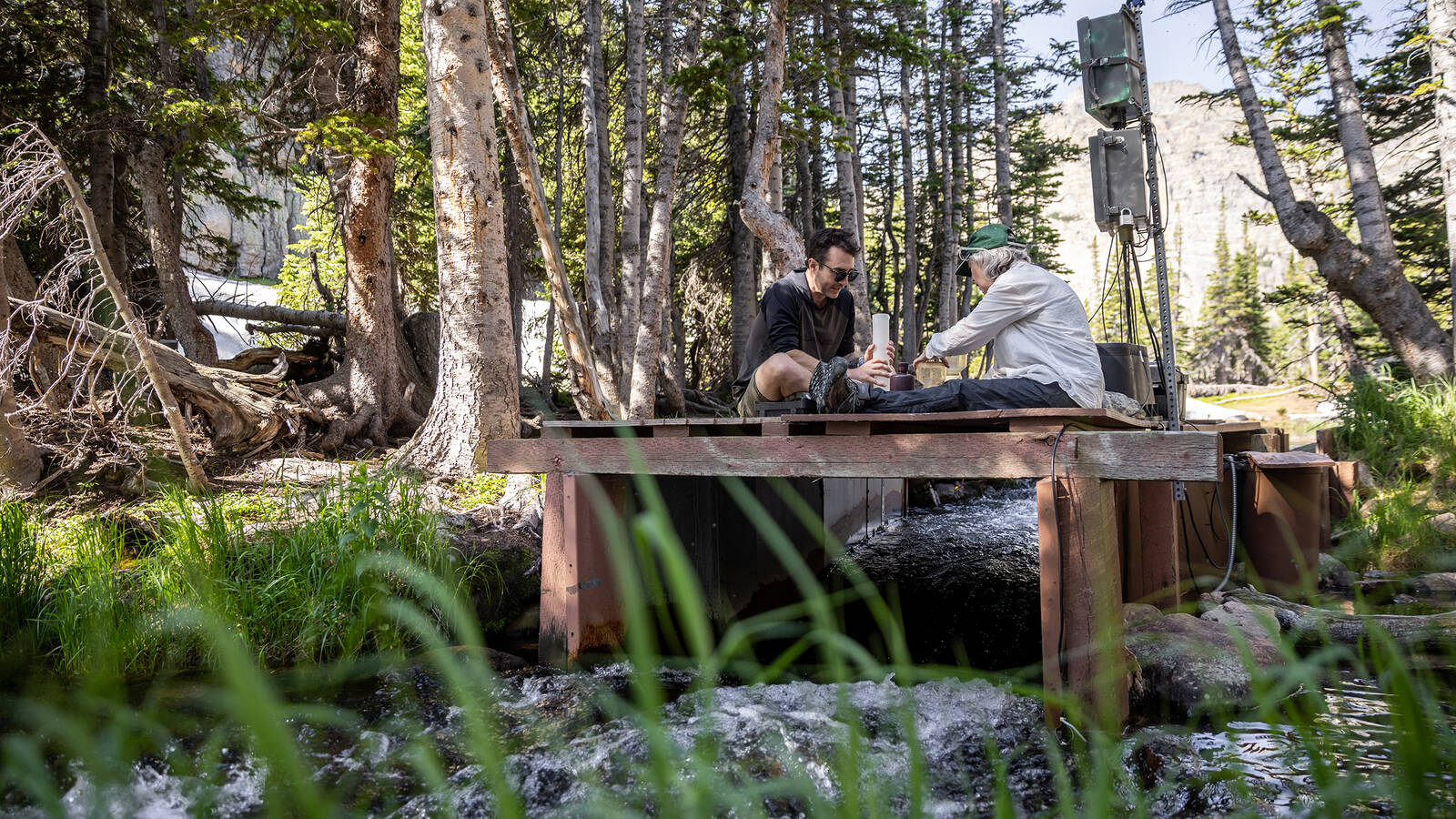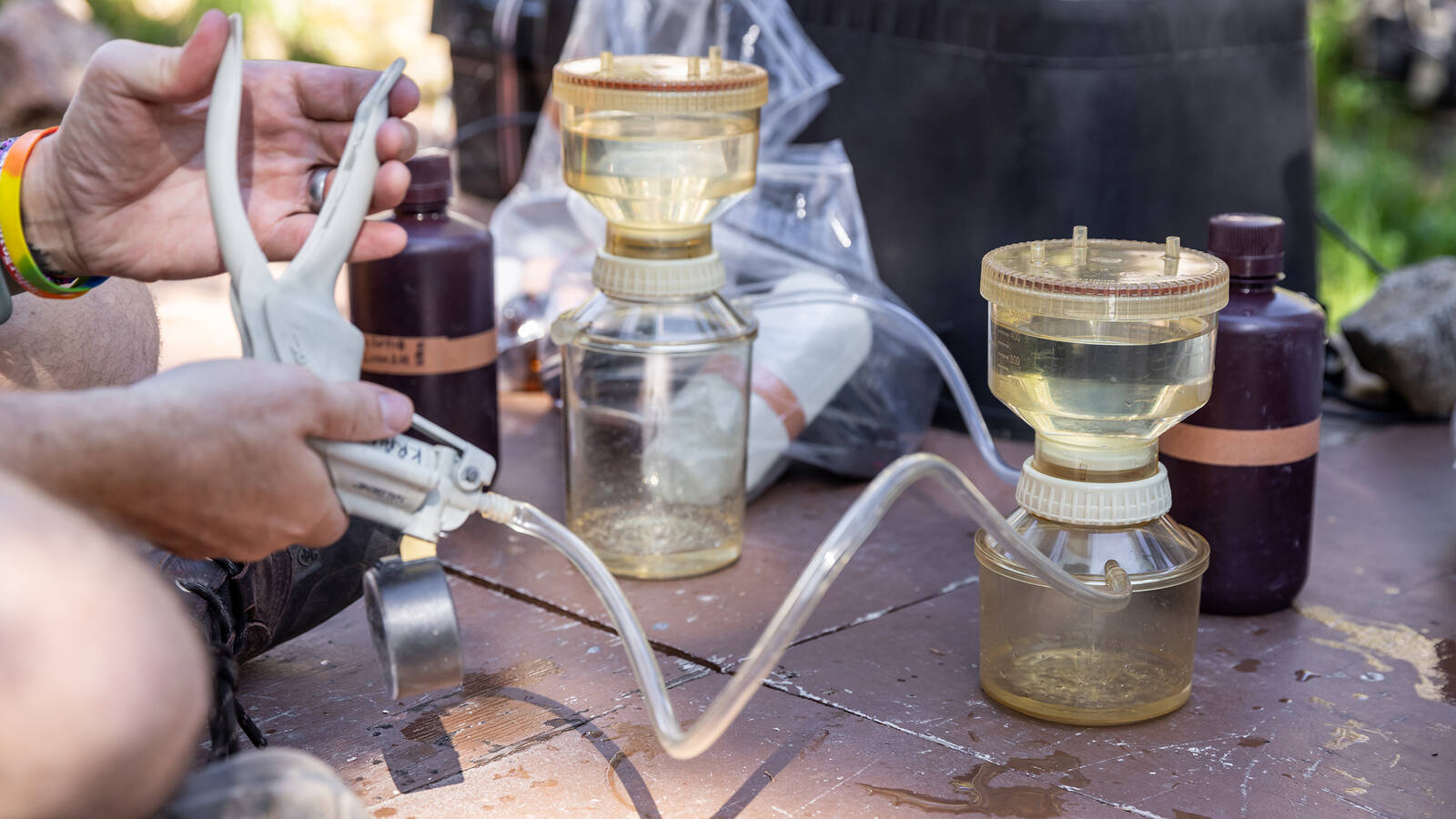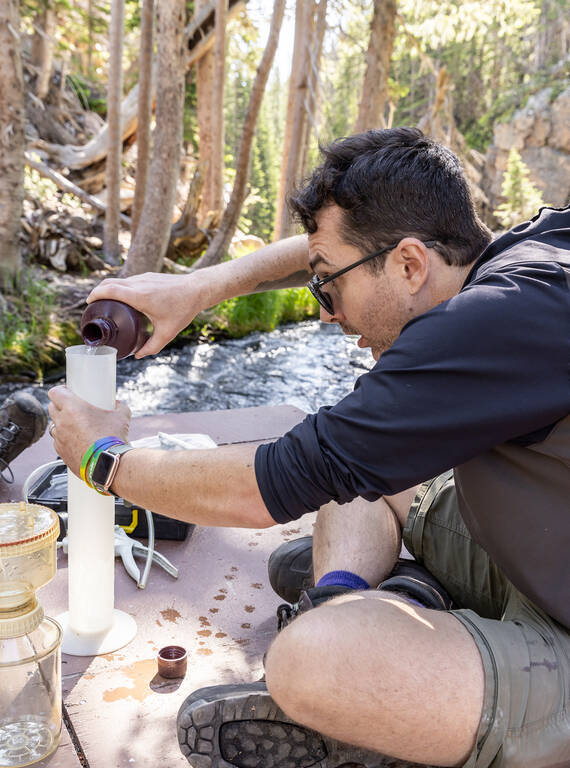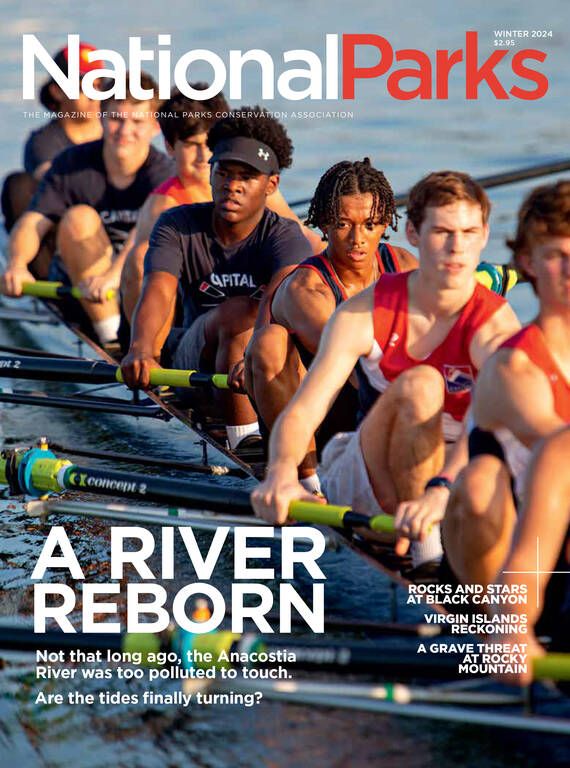Winter 2024
The Long Haul
For more than four decades, Jill Baron has studied the changes to the air and water quality of a small corner of Rocky Mountain National Park, and her research exposed one of the biggest threats to the park’s alpine ecosystems.
On a blue-sky spring day, Jill Baron, a petite 69-year-old, inflated her packraft on the snow-covered shore of The Loch, an alpine lake in the middle of Rocky Mountain National Park. When she was done, we hopped in and rowed toward a barely visible buoy in the middle of the lake, which is part of the Loch Vale watershed. Once there, Baron dropped a pancake-sized device called a Secchi disk into the water to measure the lake’s transparency, an indication of the amount of sediment or phytoplankton.
Next, Baron took out a few sampling bottles. Some had been baked or acid-washed to remove potential contaminants, but others still needed a little lake-water rinse. “I see a dog hair,” said Baron, who has a yellow lab at home, before dipping the bottle into the icy water. Following her established protocol, she collected samples of surface water. She then lowered the flexible tube of a hand pump to sample the water just above the lakebed, 13 feet below. “I don’t want to hit the bottom,” she said. “It would stir up a bunch of stuff.” After a couple of minutes of strenuous pumping, up came lake water — with chunks of algae in it. “That’s unfortunate,” Baron said. After two more attempts, clear water finally flowed through. Baron filled up her sampling bottles, and we pulled up the anchor and rowed back.
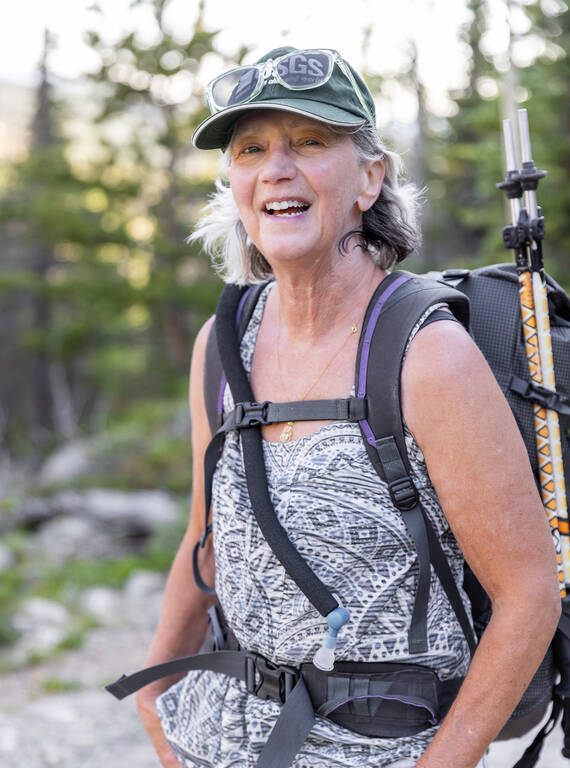
Jill Baron on the hike up to The Loch in July.
©EMILY SIERRAHundreds of times since the early 1980s, Baron, an ecosystem ecologist with the U.S. Geological Survey and Colorado State University, has made the hour-and-a-half drive from her home in Fort Collins and hiked, snowshoed or skied up to The Loch and Sky Pond, a more remote alpine lake, to collect water samples, lake sediment cores, air pollution data or other information. And over the years, her field technicians and collaborators have gone on scores of sampling trips of their own. Leveraging the resulting massive datasets, Baron and her colleagues have documented the profound and rapid changes in the chemistry and biology of these high-elevation lakes, including the emergence of algal blooms that could have cascading effects on the lakes’ food web. Their broad-ranging research into the causes of those changes — especially the impact of increased nitrogen pollution — has yielded crucial insights and potential mitigation strategies that could be used to protect fragile alpine ecosystems well beyond Colorado.
“The research that’s come out of this program is not only important to Rocky Mountain National Park,” said the park’s resource stewardship division lead, Koren Nydick, who was a graduate student of Baron’s two decades ago.
Overseeing one of the longest-running ecological monitoring projects of its kind has not come easy, and Baron has faced many literal and figurative headwinds along the way. The weather can turn dangerous, especially in winter, and securing funding has been a perennial challenge. To save money, she assembled a weather station between the two main lakes using some equipment donated by federal agencies. For several years, she couldn’t afford to hire a full-time field technician. “We had to make it up as we went,” she said. Baron has also contended with several government shutdowns, one catastrophic flood and a pandemic — not to mention the occasional tampering with her equipment by humans and animals alike. “It takes someone with a long-term vision and a lot of tenacity to sustain that over decades,” said Brenda Moraska Lafrancois, a National Park Service aquatic ecologist and one of numerous Loch Vale alums — many of them women — who now occupy prominent positions within federal and local agencies.

Polluted Parks
National parks are home to some of America’s most iconic landscapes and best-preserved cultural and historic sites, and these places need clean air and a healthy climate to flourish. Yet…
See more ›In the early 1980s, Baron was working in what is now the Park Service’s water resources division in Washington, D.C., when she wrote a proposal to collect sediment cores from lakes in Rocky Mountain to analyze the possible impact of acid rain, which had been identified as a major environmental issue in the 1960s in Scandinavia. Meanwhile, in 1980, the National Science Foundation had started setting up several long-term ecological research sites across the country, and a Park Service colleague, Raymond Herrmann, established four such sites. “He had the vision to say national parks ought to have this, too,” she said. Baron looked for a suitable site in Rocky Mountain and eventually settled on Loch Vale, a 2.5-square-mile watershed located just east of the Continental Divide. Most of it consists of bare granite, gneiss and tundra, with an old-growth forest of spruce and fir at lower elevations.
During Baron’s initial research in Rocky Mountain, she saw little evidence of acidification due to acid rain, but she and her colleagues were stunned by a different discovery: “We found a lot of nitrogen instead,” she said. “When we realized that nitrogen was falling out of the sky far in excess of what background values ought to be, we started a number of studies.”
Nitrogen occurs naturally in the soil, air and water, and it’s fundamental to all forms of life. (It’s an essential component of the molecules that make up DNA, for example.) In the form of compounds such as ammonia and nitrate, nitrogen also provides food for plants, which, when they die, return nitrogen to the soil, and some portion of it eventually goes back into the atmosphere. The problem is that emissions from livestock, fertilizer, vehicles, coal-fired power plants, and the oil and gas industry cause excess deposition of nitrogen everywhere, including in the most remote corners of Rocky Mountain National Park. Baron was one of the first to document that deposition in alpine environments, and since then, she, her graduate students and other scientists, including some from the Park Service, have conducted numerous studies to understand what happens when you inject a large dose of what essentially is fertilizer into a fragile ecosystem. Among other experiments, they stimulated the growth of 700-year-old conifers with fertilizer pellets and surveyed the algal communities at the bottom of The Loch with an underwater camera appropriately nicknamed “Nessie.” Baron even estimated how much nitrogen comes from elk urination.
It takes someone with a long-term vision and a lot of tenacity to sustain that over decades.
“We looked at forest soils, we looked at lakes and streams and discovered that everywhere we looked, we saw evidence of fertilization,” Baron said.
So what’s so bad about fertilization? Though nitrogen is good for plants, too much of it can kill them. Also, excessive nitrogen in a lake can fuel the growth of green algae, which, when they die and decompose, can create a dead zone with little or no oxygen. One of the Loch Vale project’s most striking discoveries is evidence of a measurable increase in nitrogen-hungry green algae around the year 2000, possibly at the expense of the lake’s diatoms. Later, those green algae even formed algal mats visible from the surface. Isabella Oleksy, who studied under Baron, found that green algae were absorbing nutrients and growing faster when the temperature rose. In other words, climate change likely played a major role in the algal bloom. “Probably these warmer conditions accelerated this trend that was already starting to happen,” Oleksy said. There hasn’t been much research into what this means for other lake organisms, but the consequences are likely substantial and could ripple through the food chain. “It allows some species to thrive and other species to be shaded out, essentially, or outcompeted,” Baron said.
Baron (left) and Hendry at the Loch Vale weather station.
©EMILY SIERRATim Weinmann, who was the field manager at the time, and Baron working on the platform built over The Loch’s outlet, where water exits the watershed.
©EMILY SIERRAWeinmann filters water to measure chlorophyll so that the team can estimate the lake’s algae levels.
©EMILY SIERRAWeinmann handles water samples collected in the watershed. Much of the data that was collected over the decades has not been analyzed yet, and Baron hopes to begin parsing through this trove of information once she hires a few data scientists.
©EMILY SIERRAOne data point that is critical to Baron’s research is the amount of atmospheric deposition of nitrogen collected in these buckets. In one particular instance many years ago, the level of ammonia in the buckets was “unrealistically high,” Baron said. At that time, a crew working on the trail to Sky Pond was camping nearby. “My suspicion is they all urinated in the bucket,” Baron said. “They hired children, you know. I would have done that as a kid.”
©EMILY SIERRADemonstrating the ecological impact was the first step on the path toward remediation. The Regional Haze Rule, which mandates federal and state agencies to improve visibility — and therefore air quality — at national parks such as Rocky Mountain, helps to reduce nitrogen emissions indirectly (and Colorado recently retired several coal-fired units, a move advocated by NPCA), but astonishingly, there is no federal regulation that specifically targets ammonia, one of the main sources of nitrogen pollution. Baron has published dozens of academic papers, but it is the public talks she’s given that have spurred action. Alarmed by her findings, Environmental Defense Fund and Colorado Trout Unlimited in 2004 petitioned the then-secretary of the Department of the Interior to intervene. It worked, and soon after, the U.S. Environmental Protection Agency, the Park Service and the Colorado Department of Public Health and Environment created a task force charged with finding ways to reduce nitrogen pollution in the park by half by 2032. Without a regulatory framework, all the group can do is try to secure voluntary reductions from those responsible, but “the fact that they are trying to do something about it, even if it is a voluntary effort, is still really good,” said Daniel Orozco, NPCA’s senior clean air and climate manager.
Efforts have focused on the cattle feeding operations, dairy farms and row crops that line the Front Range of the Rockies, and the agencies meet regularly with agriculture industry representatives. One of the novel approaches that has been carried out is an early warning system. The idea is that when the forecast indicates that an upcoming weather event could carry nitrogen emissions from agricultural operations to the park, farmers can minimize the impact by implementing practices such as delaying the spreading of manure on fields or covering compost piles. How widely these strategies are being applied and how effective they are is hard to say. The most recent readings in Loch Vale showed that nitrogen levels were slightly higher than the 2006 baseline (although the state’s population has grown significantly in the interval). What’s more, in a move that Orozco lamented, the coalition recently did away with a provision to consider additional measures in the event that intermediate reductions were not achieved. Baron said there are few options to substantially lower nitrogen pollution from cattle operations short of decreasing the number of cows.
We realized that nitrogen was falling out of the sky far in excess of what background values ought to be.
Meanwhile, Baron has tried to quantify the full impact of anthropogenic nitrogen pollution on Loch Vale and found that part of the problem stems from the very people who seek out the valley’s unadulterated beauty. During her sampling outings, Baron would often come across toilet paper and personal hygiene products, and she wondered if the thousands of humans who set foot in Loch Vale during the summer months made any measurable nitrogen contribution to the ecosystem. Using caffeine as a marker of human urine (because marmots don’t drink coffee, as Baron wryly noted in her paper’s title), Baron and her colleagues analyzed soil collected near visual evidence of human waste and some distance from it. They found caffeine in all the samples and estimated that 2% of the nitrogen in Loch Vale waters comes from people — a relatively small but not insignificant amount. In her discussion of the results, Baron suggested that the nitrogen contributions of visitors and agriculture are not as separate as they may seem. She wrote that the wider use of fertilizers fueled population growth and a better quality of life, which in turn translated into higher numbers of visitors to places like Loch Vale. “I admit I got carried away in this little tiny paper about a national park, but that’s the kind of thing we all think about,” she said.
None of the Loch Vale research would exist without the sampling trips that take place every Tuesday, rain or shine — or snow — to align with the day on which precipitation chemistry data is collected across a network of sites that are part of the National Atmospheric Deposition Program, a collaborative research effort. Samplers are allowed to collect on Monday or Wednesday in case of inclement weather or other emergencies, but there was no such risk on that late May morning. Before Baron, Tim Weinmann, then her field manager, and Mollie Hendry, one of her graduate students, headed out, Baron urged us to apply sunscreen. “I’m not your mother, but I’m a mother,” she said, as we loaded up empty sampling bottles and other equipment into our backpacks. The group decided that Weinmann and Hendry would hike all the way to Sky Pond, while Baron and I would sample The Loch. Baron, who likes to hike, bike and ski, repeatedly told me she wasn’t as fast as she used to be, but we moved up the slope at a steady pace.

Air Pollution in Colorado: Our Lives and Parks at Risk
Colorado suffers from a serious and growing air quality problem, failing year after year to meet federal standards for air that’s healthy and safe to breathe. That needs to change.
See more ›In winter, no one samples Loch Vale alone for safety reasons. Avalanches are rare, but conditions can be treacherous. “As you cross The Loch to go up higher, the wind is ferocious,” Baron said. “It knocks people over.” When the lake freezes, they use a hand auger to drill through the ice. It can take up to an hour to reach the water. “Tim is actually the master of this,” Baron said. “There’s no way I’ve got the upper body strength to do it.” (In October, Weinmann started a new position as air toxics specialist at the Colorado Department of Public Health and Environment.) Through all the seasons and years, Baron has been able to rely on friends and family for extra hands. While Baron’s daughter got her first ride to a sampling site when she was 4 months old, by the time she was 11, she was helping collect the samples — and her younger brother would soon follow. “They were both very good field assistants in their day,” Baron said. Years later, Baron’s son, just back from spending two years in Nepal, fashioned a tumpline to carry weather station batteries — each weighing around 65 pounds — on the last quarter-mile that the mules couldn’t cover. “Very Sherpa-like,” Baron said. “We were all very impressed.”
Lafrancois, who worked at Loch Vale when Baron’s kids were young, was struck by how Baron managed to throw herself into her work and spent time with her children while doing it. “I have incorporated that,” she said. “I take my daughter with me sampling anytime it’s feasible to do that.”
ABOUT THE PHOTOGRAPHER
In recent years, Baron has reduced the frequency of her Loch Vale trips. She now spends much of her time working on a project to improve the global management of nitrogen emissions and at the John Wesley Powell Center for Analysis and Synthesis, an earth science think tank of sorts that she co-founded. She also plans to examine all the unanalyzed data from the start of the Loch Vale project — once she hires data scientists to help.
Baron brims with ideas for research topics, and her enthusiasm for the work hasn’t waned one bit. Still, the time is nearing for her to let go of what she calls her “third child.” To that end, she’s started the process of transferring the supervision of the Loch Vale project to her former student Oleksy, who just set up her own lab at the University of Colorado, and she’s handed over the precipitation sampling to the Park Service.
“I’m just beginning to think about how to pass it on,” Baron said. “Because, you know, I am still able to do the fieldwork, but I won’t be forever.”
About the author
-
 Nicolas Brulliard Senior Editor
Nicolas Brulliard Senior EditorNicolas is a journalist and former geologist who joined NPCA in November 2015. He serves as senior editor of National Parks magazine.
